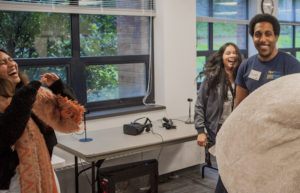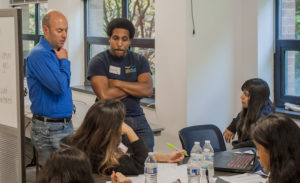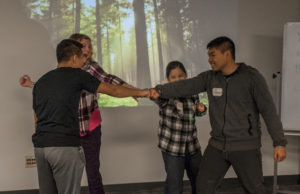Students step up for our first RealityNext Workshop
On November 11, 2017, RealityNext conducted a workshop for teens (mostly middle and early high school) to assess how our mixed-modal methodology work in the field. RealityNext’s supplemental education model enables students to collaborate on learning about a topic within a specific subject inside virtual reality, then turn the knowledge they have synthesized into a story-game to teach others what they have learned—without having to code. Our premise is that our refresher learning modules can improve learning outcomes, raise student achievement, and build critical thinking skills while the students have fun in a maker environment.
Questions we asked to set our goals for a successful workshop:
- Was it fun?
- Did the students learn?
- Did we make sure the students understood the process and the product?
- Did the research tools lead the students to the answers that would allow them to create meaningful questions for future players?
- Could they do this work collaboratively?
- Did the students enjoy being immersed in virtual reality?
We divided the workshop into multiple sections, and assessed based on each separate task, as shown in the grid below. In addition to using the above questions as our baseline, we also assessed modalities for each task based upon education pioneer Howard Gardner’s theory of multiple intelligences in his research at Harvard University. These eight distinct modalities individually and concurrently support a student’s abilities to learn through a spectrum of styles to best meet that student’s potential.
So, did we prove our concept? To answer our questions:
- Was it fun?
 Overall, yes. The students for the most part loved the VR demos. The research aspect of the day required some prodding by facilitators to keep kids on task, but because we put them in the driver’s seat we didn’t see anyone suffering from boredom. As the students took greater control of their experience in the afternoon, in particular with the story development, they began to have a really good time.
Overall, yes. The students for the most part loved the VR demos. The research aspect of the day required some prodding by facilitators to keep kids on task, but because we put them in the driver’s seat we didn’t see anyone suffering from boredom. As the students took greater control of their experience in the afternoon, in particular with the story development, they began to have a really good time. - Did the students learn?
Yes, unequivocally. With the carbon cycle, this was a refresher for most, but because we showed the carbon cycle video twice (which diverged from the original plan), drew a quick refresher on the whiteboard after, then held the rapid-fire research session based on a dozen questions, when we looked back at their research as they developed their questions we saw they had gained sufficient mastery about the subject to progress in their journey. - Did we make sure the students understood the process and the product?
 Most likely. We ensured that we provided instruction multiple times throughout the day using spoken, visual, and hands-on methods to satisfy multiple learning needs. At each transition between tasks we restated the end goal—to create a story-game that we can record in the motion-capture studio—to reinforce their conceptual understanding. We showed entertaining videos at three different times to get our points across, then revisited the concepts with drawings and asking questions. We provided tools such as laptops, colorful printouts, whiteboards, sticky notes, and drawing paper to assist with research and prototyping. We had check-ins at various points to ensure students made progress and to share thoughts. Finally, and probably most importantly, the facilitators took part in the process while ensuring the students met their goals toward completion.
Most likely. We ensured that we provided instruction multiple times throughout the day using spoken, visual, and hands-on methods to satisfy multiple learning needs. At each transition between tasks we restated the end goal—to create a story-game that we can record in the motion-capture studio—to reinforce their conceptual understanding. We showed entertaining videos at three different times to get our points across, then revisited the concepts with drawings and asking questions. We provided tools such as laptops, colorful printouts, whiteboards, sticky notes, and drawing paper to assist with research and prototyping. We had check-ins at various points to ensure students made progress and to share thoughts. Finally, and probably most importantly, the facilitators took part in the process while ensuring the students met their goals toward completion. - Did the research tools lead the students to the answers that would allow them to create meaningful questions for future players?
Yes, but…. Two of the three groups understood the order of our learning methodology—develop the questions they want to ask to move the player forward in the game, come up with multiple-choice answers, then build a story around the correct answers. These groups (and eventually the third) wrote compelling stories that made for what will become a compelling game in virtual reality. However, the two questions they developed—one about carbon release and one about carbon absorption—were more simplistic than we expected. We may need to consider pre-written questions in the future to improve the learning outcomes. - Could they do this work collaboratively?
 We believe the warm-up games helped to facilitate collaboration, because before we played those games the students largely hadn’t met and didn’t feel any ways to connect to one another. When we broke into small groups the level of collaboration and creativity met our assumptions.
We believe the warm-up games helped to facilitate collaboration, because before we played those games the students largely hadn’t met and didn’t feel any ways to connect to one another. When we broke into small groups the level of collaboration and creativity met our assumptions. - Did the students enjoy being immersed in virtual reality?
Eleven of the 12 students really enjoyed the virtual reality demos we brought in. One student absolutely loved it. One student didn’t enjoy it at all. One student really wanted to find a violent game to play, but none were installed on our machines; in addition, that would have gone counter to our mission of non-violent education. The same student wanted to add violent elements to his group’s story-game, but the team pulled him back to a scenario that satisfied everyone (and had a minimal body count).
We look forward to our second workshop, where we do the actual motion capture recording that turns the students’ stories into the final product: a virtual reality game they can call their own.
